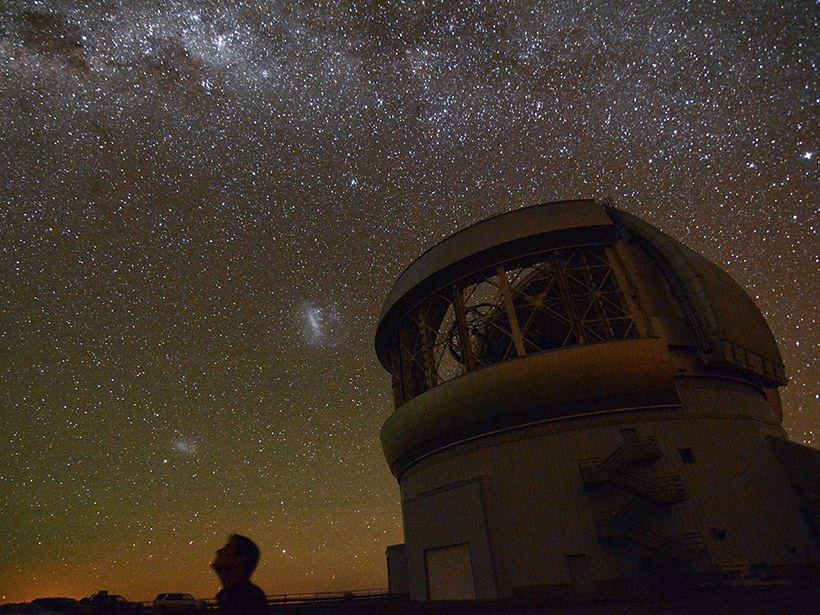Finding extrasolar planets is hard: They’re much fainter and smaller than the stars they orbit, and from our vantage point, they appear crammed next to an enormously bright spotlight.
But thanks to the Gemini Planet Imager Exoplanet Survey (GPIES), which recently wrapped up a direct imaging campaign of hundreds of stars, scientists are getting a more complete picture of these worlds and how they form.
GPIES results shed light on the evolutionary linkages among planets, brown dwarfs, and stars.
Giant planets and their larger brethren—brown dwarfs, also known as “failed stars”—form according to different mechanisms, a result that sheds light on the evolutionary linkages among planets, brown dwarfs, and stars, the new data reveal.
Most extrasolar planets found to date have been spotted by looking for tiny blips in a star’s light as a planet passes in front or by measuring a star’s “wobble” due to a planet’s gravitational tug. The Gemini Planet Imager, an instrument mounted on the 8-meter Gemini South telescope in Chile, takes a different tack.
Since late 2014, GPIES has been observing young, nearby stars in near-infrared light. A tool called a coronagraph masks out each star’s light to reveal the presence of any dim companion objects, which may be up to a million times fainter. (Because the planets and brown dwarfs that Gemini Planet Imager looks for are young, roughly 10 million to 100 million years, they’re still releasing heat from their formation and glow in the near infrared.)
Combing through data from the first half of the survey, which included observations of 300 stars, scientists found six giant planets (defined as being between 2 and 13 times the mass of Jupiter) and three brown dwarfs (more than 13 times the mass of Jupiter). Armed with information about the planets’ and brown dwarfs’ masses, temperatures, sizes, and orbits, the researchers looked for trends.
“We wanted to answer some really basic questions,” said Eric Nielsen, an astronomer at Stanford University in Stanford, Calif., and a GPIES team member.
Nielsen and his colleagues found that all six of the giant planets orbited stars at least 50% more massive than the Sun, a surprise since these stars were relatively rare in the survey. “That’s pretty remarkable,” said Nielsen.
The brown dwarfs, on the other hand, all orbited lower-mass stars. The researchers also found that giant planets orbited their host stars at comparatively smaller distances than the brown dwarfs.
Diverse Formation in the “Middle Ground”
Together, these observations imply that giant planets and brown dwarfs form in different ways. That’s an important discovery because these objects represent a sort of astronomical “middle ground”: They’re more massive than rocky planets like Earth but less massive than hydrogen-burning stars like our Sun. Given these objects’ intermediate status between planets and stars, astronomers want to understand how they form.
The GPIES observations revealed that giant planets likely form via the accretion of smaller objects, a mechanism called core accretion. That’s also how Earth-sized planets form, astronomers believe. But brown dwarfs likely form more like stars, not planets, in a process called disk instability, in which a disk of gas and dust fragments into large clumps, which then attract one another via gravity. These findings were published last month in the Astronomical Journal.
“This is kind of the definitive survey of all the nearby stars.”
“The exoplanet community is very interested in these results,” said Trent Dupuy, an astronomer at Gemini Observatory in Hilo, Hawaii, not involved in the research. “This is kind of the definitive survey of all the nearby stars.”
Nielsen and his colleagues look forward to repeating their analysis with the entire GPIES data set, which will include measurements from 531 stars and their companions.
A whole new set of observations may soon be possible as well, said Nielsen. Early next year, Gemini Planet Imager may receive an upgrade and be moved to the 8-meter Gemini North telescope in Hawaii. There will be a “whole new sky of stars” to analyze, said Nielsen.
—Katherine Kornei (@katherinekornei), Freelance Science Journalist
Citation:
Kornei, K. (2019), Giant planets and brown dwarfs form in different ways, Eos, 100, https://doi.org/10.1029/2019EO127841. Published on 11 July 2019.
Text © 2019. The authors. CC BY-NC-ND 3.0
Except where otherwise noted, images are subject to copyright. Any reuse without express permission from the copyright owner is prohibited.

